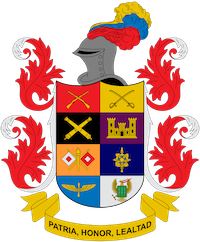The theater of Islamic terrorism
Abstract
The recent attacks by lslamic extremist groups in European cities in the light of war theories and contemporary strategic studies are explored in this article. lts purpose is to present the fourth-generation wars as a phenomenon where the operational level is the one that has more presence on other leve Is, using as an example the structuring and action of the aforementioned groups. The capacity of these groups to carry out the war between the same population will be examined and, in the same way, the characteristics that emerge dueto the typical decentralization of this type of war. All of the above, based on theories of complexity in international relations, strategic studies and intelligence studies.
Downloads
References
Arquilla, J., & Ronfeldt, D. (2000). Swarming and the Future of Conflict. Santa Monica, CA: RAND Corporation.
Baudrillard, J. (1991). La guerra del Golfo no ha tenido lugar. Barcelona: Editorial Anagrama.
Berton, B., & Pawlak, P. (2015). Cyber Jihadists andTheirWeb. Recuperado el 31 de mayo de 2016 de: http://www.css.ethz.ch/content/specialinterest/gess/cis/center-for-securities-studies/en/services/digital-library/articles/article.html/187809
Betz, D. (2015). Carnage & Connectivity: Landmarks in the Decline of Conventional Mi/itary Power. Oxford: Oxford University Press. https://doi.org/10.1093/acprof:oso/9780190264857.001.0001
Bousquet, A. (2009). The scientific way of warfare: Order and chaos on the battlefields of modernity. New York: Columbia University Press.
Bouthol, G. (1984). Tratado de polemología (Sociología de las guerras). Madrid: Ediciones Ejército.
J. Hall, W. M., & Citrenbaum, G. (2009). lntetligence Analysis: How to Think in Complex Environments. Santa Barbara, CA: ABC-CLIO. https://doi.org/10.1093/analys/anp085
Harrison, N. E. (2006). Thinking About the World We Make. En N. E. Harrison (Ed.), Complexity in World Politics: Concepts and Methods of a New Paradigm (pp. 1- 24). Albany, NY: State of New York University.
lnstitute for Economics & Peace. (2015). Globa/Terrorism lndex 2015. Sydney: lnstitute for Economics & Peace.
Kettani, H. (2010). World Muslim Population: 1950-2020 lnternational Journal of Environmental Science and Development 1(2), 1-42. https://doi.org/10.7763/IJESD.2010.V1.28
Kissane, D. (2011). Beyond Anarchy: The Complex and Chaotic Dynamics of lnternational Politics.
Kissinger, H. (2014). World Order. NewYork, NY: Penguin Books.
Lind, W. S., Nightingale, K., Schmitt, J. F., Sutton, J. W., & Wilson, G. l. (1989). The Changing Face of War: lnto the Fourth Generation. Marine Corps Gazette, 73(10)1 22-26.
Newell, C. R. (1991). The Framework of Operationa/Warfare. London: Routledge. Pillar, P. (2008). Counterterrorism. En P. D. Williams (Ed.), Security Studies: An lntroduction (pp. 376-388). London: Routledge.
Rittel, H. W., & Webber, M. M. (1973). Dilemmas in a general theory of planning. Policysciences, 4(2), 155-169. https://doi.org/10.1007/BF01405730
Rosenau, J. N. (1990). Turbulence in world politics: A theory of change and continuity. Princeton, NJ: Princeton University Press. https://doi.org/10.1515/9780691188522
Sanderson, T. M. (2015). The Paris Attacks: A Strategic Shift by ISIS? Washington, D.C: Center for Strategi.c and lnternational Studies.
Secretary of State. (2016). Foreign Terrorist Organizations. Recuperado el 31 de mayo de 2016 de: http://www.state.gov/j/ct/rls/other/des/123085.htm
Shulsky, A. N., & Schmitt, G. J. (2002). Silent warfare: understanding the world of intelligence (jrded.). Dulles, VA: Potomac Books, lnc.
Smith, R. (2007). The Utility of Force: The Art of War in the Modern World. NewYork, NY: Alfred A. Knopf.
Start. (2016). Mass-Fatality, Coordinated Attacks World wide, and Terrorism in France. Recuperado el 31 de mayo de 2016 de: https://www.start.umd.edu/pubs/START_ParisMassCasualtyCoordinatedáttackNovzoag.pdf
The Guardian. (2016). Paris attacks suspect Salah Abdeslam 'had planned to target Brussels'. The Guardian. Recuperado el 24 de marzo de 2016 de: http://www.theguardian.com/world/2016/mar/20/paris-attacks-manhunt-two-suspects-still-at-large
Ugur, M. (2015). The Paris attack: People are made to pay far disastrous government policies. London: University of Greenwich.
Van Creveld, M. (1991). The Transformation of War. New York, NY: The Free Press. Van Um, E. (2012). Why Militant Groups Fight Each Other: The Role of Support, Political Objectives and Revenge. Economics of Security Working PaperSeries, 1(64)11-24.
Von Clausewitz, K. (2008). De la guerra. La Plata: Terramar.
Wright, R. (1986). Sacred Rage. The Wrath of Militant Islam. NewYork, NY: Simon & Schuster lnc.
Zanini, M., & Edwards, S. J. A. (2001). The Networking of Terror in the lnformation Age. En J. Arquilla & D. Ronfeldt (Eds.). Networks and Netwars: The Future of Terror, Crime and Militancy. (pp. 29-60). Santa Monica, CA: RAND Corporation.













